
Viewing: Blog Posts Tagged with: training, Most Recent at Top [Help]
Results 1 - 25 of 53
Blog: Paper Pop-Ups (Login to Add to MyJacketFlap)
JacketFlap tags: equestrian, bespoke, trifold, training, horse, business card, custom, paper engineer, petrina case, Add a tag
Blog: ALSC Blog (Login to Add to MyJacketFlap)
JacketFlap tags: Professional Development, Collaboration, Summer Reading, training, Partnerships, Blogger Meg Smith, Add a tag

(Image provided by Thinkstockphotos.com)
A children’s librarian’s basket of professional responsibilities often overflows with programming demands and story time schedules. Initially, it may appear impossible to carve out time for training amidst preparing for the next presentation or serving the latest day care, but it’s valuable that we recognize how critical regular training is to our effectiveness in reaching our communities. What training do you hope to add to your basket of professional development? Summer reading workshops, departmental classes, and powerful partnerships will aid us in meeting staff needs.
Sweet Summer Reading

(Image provided by Thinkstockphotos.com)
Fairly soon, a youth services librarian’s busiest time of year will be upon us: the season of summer reading. To encourage and equip staff to meet these demands, the State Library of North Carolina offers summer reading workshops. These one day events provide a variety of sessions for staff serving tots through teens. Some course offerings focus on program logistics, such as how to develop a baby summer reading program, and other sessions highlight a specific type of programming related to the summer reading theme. A popular workshop component includes the summer reading showcase and features professional performers who share their shows with librarians interested in booking these performances for their libraries. These summer reading workshops serve as a valuable training staple for youth services staff within all sizes of public libraries across our state.
Internal Offerings

(Image provided by Thinkstockphotos.com)
Internal training is another valuable resource to place in our professional basket. Whether training is seamlessly introduced through one-on-one instruction or small classes, system-driven training remains critical when determining the effectiveness of staff’s interaction with the public. In addition to two mornings of professional development and classes offered throughout the year, our library gears biannual training specifically toward the needs of youth services staff. Staff suggestions during our Youth Services Advisory Council meetings give youth services managers the forum to provide recommendations of future training topics to strengthen their skill sets. Our spring youth services training will focus on coding programs to enhance staff comfort so we may increase these program offerings for children and teens at our various library branches.
Powerful Partnerships
Youth services partnerships, whether they are with local agencies or other library departments, frequently identity training needs. Conversations with other professionals serving children and teens offer chances to brainstorm, collaborate and to recognize areas of concern within our communities. One example of this partnership is the library’s involvement with the Child Advocacy Center. The Child Advocacy Center provides Darkness to Light training for library staffers who provide youth reference services to assist our employees in recognizing the signs of childhood sexual abuse and to minimize the opportunities for trauma.
Training experiences, found through summer reading workshops, departmental classes, and valuable community partnerships, provide a plethora of rich resources to aid in staff development. How does training strengthen the skills of staff in your communities? What type of training do you want to place in your professional development basket? Please share in the comments below!
The post A Tisket, a Tasket, Put Training in Your Basket appeared first on ALSC Blog.
Blog: ALSC Blog (Login to Add to MyJacketFlap)
JacketFlap tags: Storytime, training, Blogger Katie Salo, Add a tag
So you want to train someone to do storytime? I’m here to tell you all the secrets of storytime training.
Okay. There aren’t really any secrets. But I will tell you how my library developed and successfully implemented a storytime (and programming!) training plan. I would incredibly remiss if I didn’t mention how much of this was designed and supported by my immediate supervisor and the rest of the members of the Kids and Teens department. You know who you are — thanks!!
Storytime Training Plan (in four parts)
Training Meeting
Since we were training two staff members (who haven’t previously done storytime), my supervisor asked me to write a storytime planning guide and present it at our monthly staff meeting. I had written a similar guide when I left my previous job. I just updated it with new relevant posts to read and current library storytime procedures. I included a wide variety of blog posts for new staff to read since everyone has their own storytime style.
Observation
Then, we sent our newest co-workers out to see a storytime performed by one of our veterans! This was an awesome chance for them to see how a provider interacts with parents and caregivers and adapts to the crowd’s needs. They also had to watch my YOLO Presentation entitled Early Lit 101. These building blocks helped prepare them to write their own storytime plans for the next step.
Performing & Feedback
Here’s where we really got into the training. Each new staff member presented a storytime to four librarians. And the librarians acted the part of true children to simulate the storytime experience. That included me running around my supervisor while she was on her phone during Toddler Storytime and also involved me taking my shoe off to show my teacher in Preschool Storytime. I’d like to think that we also broke the ice and became less scary while acting like kids. Afterwards, the librarians filled out a rubric and we had a meeting with each new staff member to discuss positives and areas to work on. I’m willing to bet that a puppet was an easier audience than us though!
More Observation & Planning
And that brings me to where our new staff members are now. They are currently observing at least three more storytimes in our fall session. They are also planning (but not performing) a seven week session of any programming — storytimes or otherwise — that they would like to do. And they have assigned storytime classes for our winter storytime session.
I’m really excited to see where our newest staff members will go! They’ve already proven themselves to be incredibly up to the challenge and I am so thankful that they have been open to learning storytime — I truly work in a wonderful library.
How do you train new staff members on storytime? Do you have any tricks of the trade for storytime training? Let me know in the comments!
[Oh, and if you want to see the Quick Guide to Storytime, please shoot me an email at simplykatie (at) gmail (dot) com. Thanks!]
– Katie Salo
Early Literacy Librarian
Indian Prairie Public Library
http://storytimekatie.com
The post Storytime Training Bootcamp Guide appeared first on ALSC Blog.
Blog: OUPblog (Login to Add to MyJacketFlap)
JacketFlap tags: leadership, development, leader, Economic Development, Social Sciences, *Featured, Business & Economics, business development, innovate, leadership training, Michael Maccoby, Strategic Intelligence, Books, Economics, industry, business, employment, organizations, training, Add a tag
Leadership training has become a multi-billion dollar global industry. The reason for this growth is that organizations, faced with new technology, changing markets, fierce competition, and diverse employees, must adapt and innovate or go under. Because of this, organizations need leaders with vision and the ability to engage willing collaborators. However, according to interviews with business executives reported in the McKinsey Quarterly, leadership programs are not developing global leaders.
The post Can leadership be taught? appeared first on OUPblog.
Blog: Cait's Write... (Login to Add to MyJacketFlap)
JacketFlap tags: off season training, tips, running, motivation, art, goals, training, track, races, Add a tag
When you close your eyes, may you dream of lanes, miles, and splits.

It’s never too early to dream of track, or any running goals for that matter. But at a time in the season where your next race may night be quite close enough to ‘taste’…the motivation to brave the elements (Hello, Winter, I was over you last month.) can wane for some runners.
I often take the snarky, or sarcastic, side to life, even when it comes to a ‘kind’ kick in the right direction. Here are some ways I suggest keeping yourself consistent until it IS close enough to ‘taste’ your next race.
1) That Runner Guilt Factor: I’ll be totally honest, this is usually my BEST way to combat a motivation lull. I remind myself that skipping a run usually is not worth feeling that ‘runner guilt’ later. No joke, you know it’s not fun going to bed tossing and turning because you caved to an instance of laziness.
2) The Endorphin Factor: Close to the above, I also remind myself that even if I feel tired/sluggish and the last thing I want to do is run…that usually changes after the first 5 minutes or mile. Once you get into the run those endorphins kick in, and I’ve never finished and thought, “Wow, I really wish I woulda just kicked it on the couch.”
3) Play Antagonizer: Mental dialogue, “C’mon, don’t be a weenie. Suck it the heck up, lace it up.”
4) The Buddy System: When in doubt, call a friend, arrange a run, join a group, social media that you ARE going for a run. That way if you back out, you’ve got to deal with the ‘Tweet of shame’ later. Good peer pressure and all that jazz.
5) Training Program: If you’re training to PR, I have to say I honestly recommend you have a coach, or are knowledgeable enough yourself to coach yourself. But self coaching is HARD…and it’s a lot easier to not have to ‘think’ about your training. That way, you have someone to tell you what to do, BAM, your job is just to run. Trust me, running is hard business, taking some things off your plate is nice. Plus, if your coach gives you the workout, no arguments, lace it up, Buddy!
6) Dream of Goals: Even if race day IS far away, write it down and know your goals. Like the picture above, if you VISUALIZE what you want and put it OUT THERE, it makes things feel more ‘real’ and you know what you’re working towards. It’s harder to blow off a written goal, one you dream about, right? Methinks yes.

7) Bribery: It’ll get you everywhere. Bribe yourself with new running gear, think about dessert, splurge on some cool new shoes, dream of pancakes on your run, create a cool playlist…whatever. When it doubt, donut it out…you just have to run first. ![]()
8) Identity: Okay, some people may be all judgmental and say you shouldn’t DEFINE yourself as a runner…but I’ll be honest, a big part of who I am (or at least the parts I tend to like the most! haha) is that I’m a runner. It’s not just a passion of mine, but it’s a way I connect with people, my friends, and a mentality. I know if I’ve run for the day I feel better and am a happier individual. So race or no race, get my miles on.
9) Money in the Bank: Think of all these miles and workouts as money in the bank. The stronger you are going into the ‘meat’ of the season the better you’ll race. Doesn’t that sound logical? Picture your competitors, who do you think will do better come race day, the ones gettin’ ‘er did, or the sofa’ing ‘er did? The uglier the day/workout, the more excited you should be when you tackle it…it’s making you that much tougher.
10) Superiority: Remember that runners are just better. So go run, don’t you want to be part of the cool kids? ![]()
Snark, goals, tough love to yourself…whatever it takes. Dream of miles, and remember you HAVE the support of the entire (awesome) runner community to give you a motivation boost when you need it.
Blog: Cait's Write... (Login to Add to MyJacketFlap)
JacketFlap tags: running friends, cross country, tips, running, motivation, training, races, goals, Add a tag
This weekend they will be running the NCAA Cross Country Championships. The pinnacle of excitement for college cross country, I’ve done a few pieces highlighting a few of the front runners vying for the individual title: Shelby Houlihan, Crystal Nelson, and Patrick Tiernan.

Whether you ran cross country in college, or even went to college, or not I urge you to read them because among all of there runs a similar theme: cross country is unique because it blends the individual component of running with the team aspect. As every runner knows, ultimately, a race is against beating yourself, and while track does have a team scoring element, it is in no way like cross country’s.
Here, there is a team of seven, five runners score but don’t think the sixth and seventh man (or runner woman) don’t count. You need all seven because:
1) You never know: We’ve all had days where the gun goes off and it’s clearly not your day. If you’ve got one of your ‘usual’ top five runners amidst a horrible race, you better hope you can rely on your sixth or seventh to step up.
2) The tie: There are classic stories where it comes down to a tie breaker and a win was decided on the number sixth runner…you can bet that runner who proved a win for their team was celebrated that night!
Most importantly, while running is a test against yourself, there is an incredible bond that is formed between training partners. We’ll call is a bond build on suffering, and when you ‘click’ with certain training partners or groups that’s where the magic happens.
A partner, or team, can pull you to YOUR best.
Through the training season, time miles, the work you put in, if alongside a person/team, therein breeds a remarkable enthusiasm. The success of one is a success of the whole, and in the middle of the pain of race day you can dig a little deeper knowing that you’re racing for yourself but also for your team, your friends, the ones who are pushing through their own pain for you too.

Runners graduate, move on, change teams, but the component of having a training partner there to push you remains the same. Out in the ‘real world’ runners have many options in terms of running: solo, with a friend, with a group, finding a team, etc. Each runner decides where running fits into their life and also what ‘kind’ of running they’re doing.
Some crave the solace of a run with no one but themselves, their thoughts, and the pounding of their feet. Ample time for thinking.
Sometimes it is important to be able to grind out a tough workout by yourself because there is an important part of mental training that must occur.
But…I will say if you want to stretch yourself I urge you to try meeting with at least another person for some of those hard workouts. Ideally, a person a tad faster than yourself.
You see, running is ultimately a test against yourself…BUT, it’s because your MIND is (most often) your greatest obstacle. Having another running there ahead of you, giving you chase, is usually just enough to trick your mind into shutting up and letting your BODY prove you are capable of more.
——-
Lots of other new articles on my WRITING PAGE
I don’t update my blog daily but do on my INSTAGRAM and TWITTER FEEDS
To purchase prints of my artwork head to my ART tab! Thank you for respecting the amount of time and creative work that goes into my drawings and not using them without permissions. ![]()
——
1) Did you run for a team ever, be it in high school, college, or beyond?
2) How often do you run by yourself? With anyone else? With a team?
3) Will you make a goal of meeting someone for a hard workout in the not-so-distant future?
Blog: Cait's Write... (Login to Add to MyJacketFlap)
JacketFlap tags: tips, running, motivation, goals, training, facing fears, ask me, Add a tag
Here’s an excellent question I got from a reader recently. If you’ve got any running related questions for me, feel free to drop me a line: [email protected]
Q: Hi,
I came upon your page regarding running and could not help but be very impressed. I am a 23 year old dental student in my final year and the stress of exams has got my anxiety to higher than average levels. I am writing to you regarding advice and techniques on how to relieve such stress/anxiety through the sport of running. I previously ran 5km a day, however due to recent time constraints I have been unable to match this goal. What would you suggest in terms of distance to ensure I do not spend too much time on recreational running? What intensity do you recommend I perform? And finally what supplementation would you suggest to help me improve and relieve said anxiety.
Regards,
Dr. To Be

A: Hi Dr. To be,
Thank you very much for your kind words and I’m happy to hear you’ve enjoyed my site! I’m doubly excited to hear that you’ve experienced just how much of a rush, escape, and release running can be. So much more to running than just the physical benefits it gives us!
Wow, I’m stressed just thinking about all the school and exams you’ve got going over there, congrats on pursuing your degree and making it to the final stretch! Now on to your questions.
It sounds like you were able to become rather consistent and felt comfortable with the 5k a day, but I understand that your schedule is becoming more busy. I’ll offer some tips on ‘finding’ that extra time but in regards to you wondering what the ‘right’ amount of time spent running is, there is not ‘right’ amount for everyone. Running is great because it’s incredibly individual and that means training and racing is all fit to the person, and it’s a matter of discovering what is right for YOU. For some that could be 70 miles per week, for others it’s 20. Always remember that some running is better than no running, so for your situation I’d suggest making a goal to fit in your 5k at least 4-5 times per week. That’s a good amount to make sure you keep your fitness maintained and offer you those times to get ‘out’ of school/stress/work mode and find your escape.
Some tips I have for finding that time:
1) Run first thing in the morning. Sometimes that means waking up a little earlier but it also ensures that no matter what comes up later in the day you’ve got your run done. Take the time the night before to lay out all of your running clothes and shoes so you can roll out of bed and hit the road!
2) Packed and Alarmed. If you can’t run in the morning take a bag packed with all your running gear with you to school and capitalize on ANY free moment you have between classes or find a break. You can also schedule your run time in your day and view it as any other important meeting, it’s YOU time and important.
3) Night Runner. Some people thrive off of running out the stress of the day and like to run at night. If that’s you, instead of Netflix or TV, get some miles.
4) Multitasking. I know runners who do their studying while running, be it flashcards on a treadmill, listening to recordings of lectors or study notes recorded.
Usually there are free minutes in the day, you just have to look for them. ![]()
I also wanted to let you know that the endorphins released from running actually improve creative thinking and problem-solving. Actually taking a break to run when you’re stuck with a problem or project you can’t solve will help your work. When you come back you’ll be more productive and re-energized. So you shouldn’t feel like your running time is ‘wasted’ time that you ‘should’ have been spent studying.
For workouts, if you’d like to push yourself then start by adding some pick-ups, or fartleks, into two of your weekly runs. Make sure you have at least one easy run between them. For some fun workouts, do 1 mile easy, then alternate running 1 minute harder and 1 minute easy. Come back next time and do 2 minutes hard/easy…the combinations for fartleks are endless. I have more workout suggestions HERE.
Lastly, stress management and anxiety. A really powerful tool is visualization, which I wrote about HERE, and you can apply that tactic to all other areas of life. If you’re stressed about exams, then close your eyes and picture yourself arriving to the test area calm, relaxed, and confident. You ultimately want to get in the habit of being able to put yourself into a relaxed state, with steady breathes, and then when the actual event is happening you’re able to recall that feeling of being calm. It take practice and time, but with practice you’ll become better and better at it…just as with running!
Running offers you a unique mind-space; the chemical release of endorphins plus the feeling of freedom, lays the foundation for a happier, more productive mood overall. You may find that some of your best ideas come on the run, that is the case for me! You may also find that over time, and when you’ve got more time in your schedule, you’d like to push yourself by adding more miles and different workouts. As, I hope the relationship you’ve got with running turns into one that is lifelong.
Thank you for writing and happy studying AND running! ![]()
Cait
——
Ask Me: Solving Calf Injuries
Improve Your Running By Asking Yourself THIS Question
Blog: Cait's Write... (Login to Add to MyJacketFlap)
JacketFlap tags: running, motivation, art, goals, training, races, Add a tag
Running takes you away, into another world.
One you control.
Here, time is warped.
Shifted, ticking excruciatingly slower or insanely, much too fast.
Tick. Tick. Tick.
The watch can be a cruel master.
No one can truly see this world…
except for you.
The agony of the inner war waging,
workouts and races, outsiders don’t see.
They don’t FEEL.

But we do. Runners feel,
feel things others can’t imagine…
or would just rather choose not to.
Running’s world is at times painful,
torturous, warped,
but always magical.
Freaking magical…
addictive, alluring.
Control.
Is a finicky world.
In the end we don’t fully control this world,
but merely, the decision of whether to enter it or not.
Drop down the rabbit hole, My Friends.
Blog: Cait's Write... (Login to Add to MyJacketFlap)
JacketFlap tags: tips, running, motivation, art, goals, nutrition, injuries, training, cross training, Add a tag
Within every runner live the Yin Yang twins…the grinder and the ice-cream loving, sloth who lives to watch cartoons. We’ll call the latter the ‘recovery champ’.

While I jest, because it’s not just ice cream they love but pizza, donuts, burritos, french toast [insert runger fantasies here], there is truth to it.
In order to run hard you’ve got to allow your body to recover just as ‘hard.’ It often takes runners awhile to learn this, often the hard way. Typically everyone goes through the stage where they race every run, a run doesn’t count unless you’ve maxed out, right?! ![]() While this usually leads to improvement in the short term, eventually going hard every day will lead down the road of an injured, over-trained, mess.
While this usually leads to improvement in the short term, eventually going hard every day will lead down the road of an injured, over-trained, mess.
Without adequate recovery you’ll be too tired to actually run fast. Easy days are important, as are other ways to speed up your recovery. In order to NAIL the days that count, your hard workouts and races, you’ve got to ensure your muscles are able to rebuild and repair themselves between hard sessions.
So there IS an excuse to laze around in your sweats and hit up a Netflix marathon. ![]() Recovery is more than just an easy day too, for most mortal runners of the world running isn’t your job so lifestyle choices and how you spend the non-running hours of your day will play a big role in your ability to recover.
Recovery is more than just an easy day too, for most mortal runners of the world running isn’t your job so lifestyle choices and how you spend the non-running hours of your day will play a big role in your ability to recover.
Even for the elite runners, they are continually looking for ways to improve their recovery…because chances are there is ALWAYS room for improvement somewhere.
Take a look at your own habits and look for areas you know you could be better at. I’ve made a handy little checklist to give you some ideas of where to start:
* Make sure your easy days COUNT: rely on effort, don’t wear a watch if you have to, you should be able to hold a conversation between breathes on these runs.
* Proper Workout Scheduling: every runner needs to learn their body and how many hard workouts they can handle in a week. As we age we need to learn how to adjust, that may mean turning your ‘week’ into a 10 day cycle.
* Cross Training: I did a whole post HERE about how to maximize training if you know your body can’t handle too many running miles. Cross training on your easy days or as a ‘second run’ can help keep you healthy and allow for an ‘easier’ workout for recovery purposes.
* 30 Minute Refuel: eat a combo of protein and carbs IMMEDIATELY after your runs…especially your hard workouts. Miss this window and recovery rates drop upwards of 60%.
* Nutrition: eating to perform means opting for quality foods, timing them around when you run, and ensuring you get enough nutrients. This means protein, carbs, healthy fats, and overall enough calories to fuel your training demands. Eating to perform also means LIVING, if you’re training hard enough and want a freaking donut, you’ve earned it. Balance comes into play, so I’ll use the analogy of a silo. Fill your body with all the quality nutrients first, then any extra ‘energy demands’ needed to fill the rest of the silo should be up to you. A world without french toast is a dark one.
* Self massage: whole post on that HERE, flush out that lactic acid, keep your body knot-free.
* Hydrate: this is incredibly important regardless of the season, obviously hotter weather requires you to hydrate more and with electrolytes but even in a snow storm you’re losing moisture. Drinking after massage is also important to flush out all that ‘junk’ worked out of your muscles.
* Stretching: tied into self-massage, stay loose, limber, and avoid injuries.
* Time on Your Feet: it’s draining on your legs and energy-zapping, if your job requires you to do lots of ‘work’ know that you may need to adjust your training or learn how it affects you.
* Time on your butt: yea it’s important to rest, BUT office jobs can lead to problems too…too much sitting leads to weak glutes, tight hamstrings, and reduced blood flow. Not good for recovery, so be sure to move around and at least walk around a bit between Netflix marathons.
* Sleep: while I may leave this one for last, this is HUGE!! Sleep is when the body REALLY restores and repairs itself. Skimping on sleep will hamper your recovery, professional runners guard their sleep time and usually take naps too. Make sleep a priority. For those with sleeping problems and insomnia (ugh, join the party!) look for ways to improve the situation or figures out what can sometimes help. Restless nights add up to tired legs and eyebags. ![]()
I think that’s a solid list of ways to improve your recovery habits. Start cracking! To let that grinder perform at it’s best, that recovery-er needs to be doing it’s job right too! ![]()
—–
New ART is listed and available for prints on my page there…restructured to make things a little easier. As always, anything not shown, email me a request and I’ll get you a print.
—-
1) What are some ways you make recovery a priority?
Blog: Cait's Write... (Login to Add to MyJacketFlap)
JacketFlap tags: tips, running, shoes, injuries, training, exercises, strength training, stretching, ask me, Add a tag
I always love getting mail from readers and I often get questions which, because I could talk/write/draw about running all day, I’m always happy to answer. The other awesome thing about bloggy-land and our cyber-culture is constantly making new friends. I enjoy hearing updates back from the runners I’ve ‘met’ after they’ve sent questions and it’s always cool to watch them go on to run healthy and set new PR’s.

Well because great minds think alike, or at least I’m certain questions I’m emailed are ones others probably have, I decided to share a few. If you’ve got a questions feel free to email me at: [email protected]
Without further adieu:
Q: Hi! Do you do your calf strengthening exercises before or after running or on days off? Just curious… I am 45 and returning after a 2 month hiatus. After a 14 day streak (7 @ 20 min and the 7 @ 30 min, my calfs are starting to get cranky)
Do you think everyday is good for us over 40 runners or should I be taking days off?
Thank you so much. Your pages are very helpful?
~ Dan in Portland, OR
A: Hi Dan! Thanks so much for your readership! First off, CONGRATS on finally getting back to running!!
As for your questions: I’d suggest doing the strengthening exercises every other day, but do lots of stretching every day. Always post-run on both of those, for the stretches do the standing wall stretch both standing with your leg straight and and then with a slight bend in the knee, that will work both calf muscles. Also do one with a heel drop, so stand on a stair and just let your heel drop, slowly working deep into that achilles stretch.
As for your running, every single person is different, so it’s a matter of figuring out your running ‘sweet spot’. For now, with being cautious for your cranky calfs, tailor back to 4-5 days and you can totally do some cross training that doesn’t bother it. Then as the calfs calm down, gradually try increasing total time running, be that either running longer OR with added days running. Aim for only increasing 10% total miles each week, then let those calfs be your guide.
Finally, don’t overlook that the body is a whole unit, so be sure to check out if you’ve got other imbalances that could be setting you up for calf pain, and stretch the whole body. Check your biomechanics and you might need some insoles for added support. Also, make sure you’re running in the right shoes and they’re not ‘dead’…you’d be surprised how ‘easy’ things like needing to replace your shoes can totally clear up your symptoms!
Hope that helps, sorry for the novel reply, and say HI to Portland for me…miss that awesome city!
Happy Running!!
Cait
—-
Related Reads:
The Imbalanced Runner: Pinpoint your weaknesses and avoid injuries
The Low Mileage Runner: How to maximize your performance off of low volume
3 Ways Running Can Fly By and 500 Reasons to Update Your Running Shoes
Blog: Cait's Write... (Login to Add to MyJacketFlap)
JacketFlap tags: tips, running, goals, training, cross country, workouts, hill running, treadmill running, cross training, Add a tag
Runners are constantly climbing. It’s in our nature to always have a goal we’re working towards, always wanting to push ourselves to do better. Whether it be chasing new PR’s, challenging yourself to expand your race distance range, or even after we’re past our ‘PR-PR’ years, redefining the times and bests (weekly, yearly, masters, etc.) bests.
Diversity. Fitting as it is now cross country season that we talk about diversifying your running and climbs. Cross country thrives on both. I’ve done posts on just how awesome hills are at improving your strength and power, which translates to speed. What I haven’t talked too much on are prolonged hill climbs.

The long climb, yup. We’re talking taking your tempo runs to the trail, or inclined treadmill if you don’t have a stretch long enough outside. I’ve previously featured the man-beast that is Michael Wardian and he’s no stranger to treadmill running.
While he’s one of the World’s best ultra and trail runners, a major chunk of his miles are done on the treadmill so he can fit his runs in around his family’s (namely his kids’!) schedules. Wardian loves a good, long climb.
He makes sure to do hill work a few times a week and, “for me that means hours of running up vertical inclines, sometimes fast, sometimes just a long grind, but always pushing to get better.” Wardian is an ultra runner after all.
Another big fan of prolonged uphill runs is Sage Canaday, a staple workout for him is an uphill tempo run. Canaday is another World leading ultra runner [check out my feature on him HERE], residing in Boulder, CO he has no shortage of trails to mountain goat up.

Yo, that’s my rockstar dad running 50 miles! :)
Even if you’re not one of the best in the World, taking advantage of prolonged hill climbs will benefit you. Coach Brad Hudson of the Hudson Training Systems, coaching both elites and all levels of runners, regularly incorporates uphill tempo runs for his runners.
Try It:
Take your next scheduled tempo run to a hill, keep the distance the same and adjust based on effort. [Captain Obvious: Your times aren't going to mean much, so go off of effort.] I’d suggest going 4-5 miles.
No hill? No problem…take it to the treadmill. For a moderate climb set the grade to 4% for your tempo run and again, go off of effort. Do your warm-up and cool-down at 1.5%, as that’s the equivalent to running outside on the flats…after you jack that incline up and finish your tempo run, upon lowering you’ll see just how much ‘easier’ the same pace will feel at 1.5%!
If you’re looking for a steeper incline, Captain Obvious tells us you can just elevate the treadmill. ![]()
Another twist courtesy of Coach Hudson would be to make your hill climb tempo progressive, begin the workout at a 2% grade and have it up to 6% by the time you finish.
Life’s a climb after all. For runners, we take that both figuratively and literally. ![]()
——–
More workout posts HERE
Need some motivation to get ‘er done…look HERE
Sweat hard, recover hard… #SweatsintheCity style, Baby!
——–
1) Are you running cross country season?
2) How do you incorporate hill work into your training?
3) Have you done incline tempo/threshold work?
Blog: Cait's Write... (Login to Add to MyJacketFlap)
JacketFlap tags: tips, running, motivation, goals, injuries, training, exercises, stretching, cross training, training tips, Add a tag
Being patient sucks. Waiting for what we want isn’t fun, but the reality is that often times we are forced to wait. Even more often is it that rushing things will ultimately leave us more frustrated in the long term.
As runners, wouldn’t it be awesome if we could just lace up and make our next race/workout/run a PR? If only, right?! The natural tendency to want those faster times and better fitness TODAY is the breeding ground for injuries, overtraining, and slowed progress. Beautiful irony there, right?

Every runner has been guilty of it, and hey, some things you just have to learn yourself the hard way. (Sometimes a few times to really NAIL that lesson home.) Being patient sucks…but we need to learn to embrace it.
Yikes. Where’s the spoonful of sugar to wash that down? Well that comes when you actually ARE patient and watch your goals materialize…eventually.
The sweetest victories only come after enough struggle and work, after all.
Convincing yourself to wait it out and be patient is tough and often an on-going battle. Incidentally a large part of being able to stay patient comes from confidence. How so?
Being patient means BELIEVING in yourself, what you’re doing, and the process. A runner who lacks confidence is the one who tends to rush things, an example of that is going out way too fast in a race. It takes MORE confidence and patience to go out controlled and then pick up the pace, and close fast. A runner who tries to ‘make a buffer’ by going out too fast is subconsciously affirming they are going to slow down. See how that’s not a good way to think? It takes more confidence to be patience, wait, and then respond to your competitors (or go faster) as the race progresses.
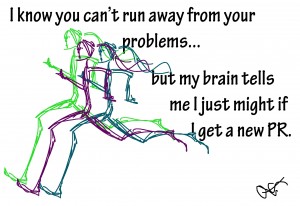
New runners can be a little less than confident in their abilities as they venture into a new sport. That’s natural, but it’s dangerous to go into information overload and want to do EVERYTHING and anything they read about training and incorporate it right away. This usually leaves them injured or too sore/tired that they lose any desire to continue running.
Even if you’ve been a runner for years and years, it’s quite easy to fall into the same trap of wanting to add in XYZ all at the same time…to rush the process. You know what, the same road leads to the same place.
Avoiding injuries and reaching your best takes time. Waiting is hard and it can suck at times, but if you try and rush things too fast it will, in the end, it will suck even more. (nightmares of time off or on the cross trainer missing your race should help keep you patient. ![]() )
)
There really ARE tons of training elements to keep you improving and progressing through the years. This should be exciting news, it’s just imperative not to rush things.
I will say that the BEST way to stay patient and keep yourself honest on the right track (in the moment it can be REALLY hard sometimes to know you need to be patient) is to a have a coach. If not a coach then at least an educated source or training group to bounce things off of. Today it’s important to recognize the source of the training advice you’re getting and if it’s actually got merit.
Being patient can suck in the moment, but eventually it is oh so sweet.
—-
More posts on training tips HERE
Some of those ‘extra’ training elements to help you improve: CORE STRETCHING DRILLS
—-
1) How do you remind yourself to stay patient when you really don’t want to wait?
2) What keeps you honest/patient when it comes to your training?
3) When is an instance where NOT being patient made things much worse for you?
Blog: Cait's Write... (Login to Add to MyJacketFlap)
JacketFlap tags: tips, running, motivation, injuries, training, stretching, core, recovery treatments, cross training, Add a tag
Nothing unites complete strangers more than discovering they are both, in fact, injured runners. Because let’s be honest, no one REALLY understands the agony us runners go through when we’re deprived of our ‘fix’. Miles give us endorphins, take those out of the equation and you do the math. It sucks.
Run long enough and you’ll get injured. It’s a fact. Darn these humanoid bodies not quite engineered to put up with everything we want them to do in training and racing. This isn’t to say there aren’t plenty of ways we can limit our injuries, and yes, us runners can be quite stupid sometimes in getting ourselves injured, but at a certain point you will get injured despite doing everything you can do right.

But don’t think of that last line as a free pass to just go willy nilly, throw all caution to the wind then, when you do wind up hurt, pretend you have no clue why. Let’s start with the stupid:
• Denial: Oh we’re the queens and kings of denial, us runners. “It’s not really that bad, it doesn’t hurt that much” thought as we hobble around the house in search of more ice.
• Grimace Face: We know running hurts, but when every stride sends a shooting pain (which you’re of course denying exists) your face gets twisted into a grimace that would make Frankenstein look beautiful.
• Random Prayers: You go to bed praying you’ll wake up and magically everything will just go away. No other logic there but a runner clinging to any shred of hope.
• Eff It, I Can Finish: Said during any run or workout, you’ve denied the shooting pains for as long as possible, somehow still believing that if you just muster on through this run, get done, things will still be peachy keen.
Clearly we all have to learn from our stupid mistakes. We’ve all been there, hopefully the older we get the wiser we get. Because let’s be honest, denial doesn’t change the situation.
Over the stupid, here are the proactive:
• Self-massage: Runners if you’re not in a love/hate relationship with your foam roller, I urge you to get cozy with it. Give him or her a name even.
• Stretch: Static and dynamic stretching post run.
• Core and Strength: Strengthening your core and WHOLE body to limit the compensation issues resulting from weak muscle groups.
• Ice, Smart, Recovery, Etc: You know the drill there.
• Form Work: Ties right into strength, run more efficiently and you’ll be doing less wear and tear on your body.
I’d like to take a minute to emphasize that if you’re not doing some kind of core or strengthening routine you’re not addressing issues that WILL eventually get you injured. Not a single runner in the world pops out perfectly balanced and with perfect biomechanics. Most runners have tight hips and weak glutes, just two major issues that cause many a runner heartache come injury time. What’s more is there tends to be a little too much emphasis on stretching alone. YES you need to stretch, but save some of that time for core work because you can’t stretch away a weak muscle group if you get my gist. I’m not talking about hitting the weight room like a Jersey Shore’r (a little dated reference but I was watching a comedy earlier that did a bit on that so it’s on my mind), and in fact many of the most effective exercises for runners can be done with bodyweight or with a swiss ball. I did some posts HERE with some of those.
Crash Course: Mentally Surviving an Injury
Back on topic. So you do your preventative but like I said injuries will occur. When you’re laid up you’ll most likely experience a few emotions.
• Rage: Like wanting to literally rip off your leg just so you can smash it against a wall, infuriated that ‘it’ let you down.
• Remorse: I abstain from the word depression, but it’s like a hair away.
• Anxiety: Is this going to EVER end? Will I EVER be able to run without pain, ever? Getting up in the middle of the night to go to the bathroom and you sorta ‘test’ jog down the hall, “Crap! Still hurts!”
• Envy: Oh that lovely runner envy. Daydreaming about hopping out of your car and slapping in the face the person you see running down the street. It’s not something to be proud of, but every injured runner thinks it. ![]()
• Rage: Yea, you circle on back to rage.
I blame it on the lack of ‘proper’ endorphins for our crazy train ride of emotions and THESE are the things that our family and friends tend to have a hard time grappling with. To every runner who’s gotten, “But it’s just running” and you have to literally hold your arm down from punching that person in the face…yea, that’s a normal runner reaction.
The thing is, while I like to joke and jest and be comedic about Runner Rage (it’s totally legit and an excuse that I think should hold up in court, “Sorry, I’m not fully in control of my actions, I’m a runner who’s not able to run at the moment”) I’m also the first person to say this:
“Force that positivity down. Choke it down and keep it there. Fake it.”
Yup! That’s the only way to get through an injury. You keep yourself OUT of that depressive and overly-anxious mindset because if you don’t you’ll stay right there…stuck.
How I deal with Runner Rage is making fun of myself and being sarcastic. Rather be laughing than wallowing in sadness. What also helps is to feel proactive during your recovery meaning: cross train, core, massage, find out where your weaknesses are and target them. Come up with a recovery plan and start the execution. The other really important thing is:
Take it ONE day at a time.
Think only through the day. Because thinking of weeks and weeks of the elliptical or bike is, well, depressing, right? So just get through the day.
And there is always this: you’re not alone. There are other injured runners out there. And there are non-injured runners who know EXACTLY how you feel and what you’re going through and they sympathize and are sending you heal up fast vibes!
Blog: ALSC Blog (Login to Add to MyJacketFlap)
JacketFlap tags: Professional Development, story time, Summer Reading, Storytime, training, programming, August, Blogger Meg Smith, Add a tag
The month of August is a hybrid of sorts as we transition from our summer reading program to the traditional activities planned for the new school year. When August 1st rolls around, do you breathe a sigh of satisfaction after the completion of your successful summer reading club, or do you still have weeks and weeks left of the summer rush before the children return to school? What does your library do with August?
To Continue Summer Reading or to Conclude Summer Reading: That is the Question
In years past, our summer reading program ended on July 31st. While June and July are much busier months in terms of the foot traffic we receive, there are still weeks left to most children’s summer vacation. This year we extended our summer reading club to August 15th to allow children and their families more time to participate in our reading program and to collect their prizes. What is your last day to conclude your summer club?
Less Programs, More Planning
Our weekly scheduled story times take a break after July 31st until the 1st of September. While we do temporarily discontinue our weekly story times, we offer the occasional preschool special, school-age program, or teen club to bring people into our libraries. With more flexibility in scheduling due to less programming, staffing the desks becomes easier even with staff members on vacation. We also focus our attention on our fall programming sessions, so we are able to hit the ground running when our story times resume and our special programs increase. Is your August full of story times and outreach visits, or do you completely break from programming to best prepare for the fall?
Taking Training
It may be close to impossible to take training or make assessment a priority during those busy summer reading club months. August is a time for renewal in terms of staffers’ professional development and is an opportunity for many of us to take in-person training, webinars, or self-paced study. It’s a necessary step for us to consider how to best enhance our own career development and also to assess the direction of our children’s libraries. Is August a traditional training month for you, or do you focus on children’s services trainings during another time of the year?
Expanding the Vision
August is a time to recharge, to assess our services, and to plan for the fall ahead of us. It’s an opportunity for us to consider major system initiatives and how to best streamline our efforts. We are now working on our plan to partner with other county agencies through the Eleven Days of Love Drive for pet-supply donations. We will include pet-themed elements in our programming as part of this collaboration. Are there any programs or services at your library that you will implement in the future that you plan now before the kids return to school?
Within our individual libraries throughout the country, there is tremendous variation with our involvement in summer reading clubs and children’s programs during the month of August. In your library system, August may provide the time needed to assess, evaluate, and focus on youth services training, or it may be a major programming month with a summer reading finale still on the horizon. Please share how you address programs, services, and training at your library during the month of August. Let’s begin a conversation in the comments below!
Blog: Cait's Write... (Login to Add to MyJacketFlap)
JacketFlap tags: running, motivation, goals, training, intervals, races, facing fears, tips, Add a tag
Long runs and long workouts tend to scare people. It can feel intimidating looking down the barrel of a double digit run or mulit-mile repeats. We’re distance runners, we love this stuff, but large quantities of miles (especially faster miles) still intimidate us.
Running and that mental component, can’t escape the mind games. Our bodies are apt to surprise us and prove our limit-setting minds wrong…BUT it’s a matter of pushing past the mind crap (doubts/fears/discomfort) before we can be ‘pleasantly’ surprised.

The best thing about running into new territory, be it your longest run, the most number of long intervals, or the most volume of hard running, they’re all scariest before you do them. Once you’ve conquered the best you’ve proven you’re capable of it and you get a new frame of reference.
Example: You’re afraid of running 10 miles because you’ve never run that far. You then run 10 miles and flash forward a few weeks and 10 miles doesn’t scare you at all. But 14 miles does…sooo, you run 14 miles and the cycle continues.
See how DOING something takes the fear out of it. Let’s up the ante.
You can run 10 miles but now you’re supposed to run them hard. EEK!!! New challenge. Time to fight through it:
4 Steps to Get Through the Grind
1) Relax:
the first part is you gotta stop building the run or workout up into epic proportions. Say with me, “it’s just a workout (or race), all I can is my best, so that’s the goal.” Deflate some of that pressure and take the power away from the workout…give yourself the power by realizing that you’re going to give it your all and THAT is all that can be expected. Times are there for guidance and motivation to push…but you can’t let them put so much pressure on you that you implode.
2) Start: easy peasy, right? Funny how fear sort of get muted the second the gun sounds and you just START freaking running. It has a way of shutting your brain down for a bit or at least taking it down a few notches.
3) Segments: your runner-brain gets overloaded thinking about the WHOLE run (26.2 miles…holy crap!!!) so you break everything down into smaller segments. Think of it like a meal with a zillion courses if you have to. Get through the plate, the miles, the quarter mile, the repeat.
4) Fight and Lie: running isn’t easy and training is painful. You break it down into itty bitty ‘plates’ but even each bite is still hard. (can I push this metaphor any further?) You need to just cycle through the above three steps on repeat…relax, roll, be confident, be smooth…start, click the watch on that next interval and go, make it until you hear the magic Garmin beep of another mile and keep going…segment, make it 100 meters more, run until you pass that guy, stick like GLUE behind the person in front of you and don’t think how far the finish line is in front of you.
Doing all of the above is really a series of lies. The good lies that you use to ‘trick’ your limit-setting brain into proving itself wrong. Your body CAN keep going, you just have to fight like h*ll long enough to show yourself you can do it.
The cool thing is once you get through the grind you’ve just re-calibrated what’s ‘suuuper scary’. Whatever you just did won’t scare you so much next time…
…but don’t rest too easily, Runners, because that just means later the ante will be upped. That’s okay, because you know the drill. ![]()
——
“The Big Three: Talent vs. Work Ethic vs. Mental Toughness- Which matters the most?”
“Effective Mental Strategy: Race better by out-thinking your brain”
——
1) What’s the longest you’ve run?
2) What’s your favorite long repeats workout?
3) How do you get through the grind?
Blog: Cait's Write... (Login to Add to MyJacketFlap)
JacketFlap tags: goals, training, tips, running, Cartoons, motivation, Add a tag
I had a fun dialogue with a friend and editor the other day:
“‘How to Train for a Marathon in 5 Minutes a Week’ and ‘Eat 20 Apples a Day to PR’ (clear exaggeration but you get the point). I know a lot of people like those types of articles but over the years I’ve have my fill.”
“Thank goodness you hate the ‘fluff crap’ kinda articles too. I die a little inside every time I’m asked to do one, writing that stuff makes my brain numb.”

There were more little barbs in there and witticisms but you get the picture. The ‘fluff’ crap; it’s all over the web and even in the magazines and websites ‘we’ us ‘real runners’ read and subscribe to. We can’t escape it and let’s be honest the masses are looking for a kind of ‘quick fix’. So, the headlines screaming BIG rewards LITTLE work draws people in. It sells. Websites and magazines are businesses after all, so even though I’m sure it kills a few editors and writers every.single.time they must do a ‘fluff crap’ article, they do it. Gotta put food on that table.
The thing is though, which ‘we’ ‘real runners’ know is:
* there’s no magic bullet
* no super secret way to getting better and stay fit
* eating an apple at 3:19pm to drop 30 seconds off your 5k PR aint gonna do it
Most people don’t want to hear that it takes:
* a h*ll of a lot of hard work
* motivation
* motivation even when you aren’t motivated
* pushing yourself
* hurting in workouts and races
The sufferfest that is training and racing…that probably wouldn’t be a magazine the general public would just LOVE reading about. Better to think that a protein smoothie with chia seeds is all that’s required and will do the trick. Training and all that stuff, well…that’s second tier, right? ![]()

The ‘training fluff crap’ I think actually parallels what writer, coach, sports nutritionist, and athlete Matt Fitzgerald, writes about in his latest book DIET CULTS. I literally devoured that read in two days so do check it out, I think most fitness minded folks will relate to a lot of what he’s saying and laugh because as athletes we’re able to ‘sniff out’ lots of the ‘diet fluff crap’ mainstream media and individuals try to get us to buy into. I will revisit this book later because I’ve got both an article on RunBlogRun coming out and after that is published do a review on this blog. So hold tight, but in the mean time check out DIET CULTS.
Getting back to the fitness and running ‘fluff’, I find that it really is only doing a disservice to the individuals who really are motivated or the ones just starting out in the sport. Coming to the realization that it’s hard work over really anything else is a learning curve all runners go through. Experience teaches us that.
Every single runner has their own journey, the progression of getting crazier and crazier more experienced and for lack of a better term ‘hardcore into’ our sport. That journey makes each runner who they are and it’s important to learn lots of those lessons yourself. At the same time, it’s a shame that falling into the misconception that certain foods or cramming 4 months of training into 2 weeks doing a run only every other Tuesday WILL make you a better runner. Because by hiding the truth you’re only stunting the progress of the runner who really does want to be their best.
Certainly the ‘fluff’ sells and the driven, self-motivated folks who are ‘real’ runners [I only define 'real' runners not based on speed at all, but in spirit and how motivated they are...if you're a runner you know it in your bones.] are the minority. But the numbers of runners are growing and it proves there are eager, motivated people looking to embark on their running journey.
Welcome to crazy town.
So here’s some straight shooting for you:
* It’s going to hurt.
* There’s no ‘secret’ to getting faster and staying fit.
* Motivation is your weapon, consistency reigns supreme.
* Patience sucks but it’s required.
* Learn that unnecessary suffering isn’t going to make you better. Oh running, filled with all those fine lines we must tread.
But here’s the BEST part:
* There’s a sick sort of high and remarkable afterglow to that hurt when you’ve pushed through it.
* Nothing is more rewarding than watching yourself get faster and more fit.
* Realizing your body can DO things you never dreamed possible is far more satisfying than any pack of abs or what your vehicle of performance looks like.
* Running will effect, and improve you in all areas of life.
* Runners are tough as s*t.
It’s important to realize that clearly certain foods and a healthy diet will help your training, lifestyle adjustments (hello more sleep!) will too. But even a healthy diet with 10 hours a sleep at night is useless sans training. Take your ‘fluff’ and shove it. #run
More Reads:
5 Ways Runners Can Use Trail Running to Get Faster
Runger: How runners can tame the beast and eat to perform
WEAR your motivation with Ezzere
Blog: Cait's Write... (Login to Add to MyJacketFlap)
JacketFlap tags: tips, running, motivation, training, hill running, Add a tag
Trail running makes you strong. It can also make you faster. “But wait,” you think, “I look down at my watch Garmin afterwards and the times are slower!” Ahhh…it all comes back to effort, My Dears, effort.
Hills take a LOAD more effort running up than running on the flats. #lessonfromcommonsense Haha. Force those legs of yours to put in the extra effort needed to get up those inclines thought and you’ll build power. Now a lesson in running mathematics:
Power = Strength = Speed

Blast up those hills and the second you take it to the track or flats, you’ll be thinking how much ‘easier’ it feels. This summer, take it to the trails (the right way) and you’ll come out stronger, faster, and ready to kick butt. It’s not just about ‘base building’ it’s about ‘power building’.
5 Ways to Do Your Power Building Trail Running RIGHT
1) Get Efficient:
You’re not doing hills right if you’re hunched over like Quasimodo. Hills make it even more important you hold proper form. Check out my post on form HERE and when taking it to the hills remember:* Stand Up TALL: Keep that torso straight!
* Don’t Lean: Don’t lean too far into the hill, keep your center of gravity above your hips; your hips will naturally be SLIGHTLY leaning into the hill, but you should think in your mind about standing up straight because quite honestly you’ll probably ‘feel’ like you’re leaning WAY back behind you but in reality are where you need to be. Focus on staying upright.
* Shorten Stride: Keep the same effort running up the hill but shorten your stride. Focus on the faster turn-over and power up that hill!
2) Eyes Ahead: Keep your eyes focused on the top of the hill, you want to power all the way UP and THROUGH the crest. Too many runners make the mistake of powering up and stopping juuuuust short of the crest which means they lose all that momentum they worked SO hard for getting up. Run THROUGH the hill so you can use that momentum to power down it.
3) Blasts vs. Endurance: Just like track and flat speedwork, hill running workouts should be tailored to match the goal for the day’s workout. Short 10-30 second hill blasts can be thought of like plyometric work. It will REALLY build that base speed, it’s all fast twitch; so remember to take FULL recovery for short blasts, as is the law of the sprinters and taxing the anaerobic energy system. Longer hill repeats and doing tempo workouts on a hilly course will further build that endurance and strength so when you take it to the flats the same EFFORT will yield much faster times. It’s always cool to step from the hills to the track, look at the watch and surprise yourself, no? ![]()
4) Rolling and Exploring: Even doing your easy days on the trails will build power. Over time the ups and downs make you stronger; it’s important to keep your easy day EFFORT easy though so you’re still actually recovering. So again, ignore what the watch says and run for effort.
5) Downhill Running: It’s important to remember that everything that goes up, goes down. #duh Running downhill puts a lot of stress on the body and as any Boston Marathon runner can tell you downhills can REALLY do a number on those quads. Downhill running isn’t ‘easy peasy’ on the body. So if you’re training for a race with lots of downhills it’s smart to practice running downhill. If you’re prone to injury beware, because the extra pounding can cause knees and ankles to get cranky. Final tip on running downhill: don’t FIGHT it. Relax, let gravity help you, and don’t try to fight it…roll with it, Runner Babes.

So if you’re not sold on hills and exploring trails, and that they will make you faster, yet…just go to Instagram and check out some of those nature pix those avid trail runners are posting! The miles will fly by. Go out…explore, adventure, LOVE the run!
——–
CHECK IT OUT!! Ezzere made Competitor’s list for TOP fitness tees!! Wahooo…the Peacock Runner Tee, sitting at number 3 on the slideshow. ![]()
——–
1) Best, most amazing trail run you’ve even been on?
Nisene Marks Park in Aptos, CA. Go there.
2) Favorite hill workout?
Blog: Cait's Write... (Login to Add to MyJacketFlap)
JacketFlap tags: training, track, races, tips, running, Add a tag
I live in California so even though June 21st is ‘officially’ the first day of summer, I’ve been running in a hot box for weeks already. Never fail, during some of my summer runs I always get that Bush song, “Speed kills…” stuck in my head but I swap out the word to “heat kills”. #truth
Running when the brutal sun is scorching you isn’t my favorite thing. But until we find that perfect seasonless runner utopia we must deal. For those runners in humid states, good lordy I’ve spent some time running in those conditions and had to come back and wrench out my running shorts and sports bra, easily a couple cups of sweat there! haha.
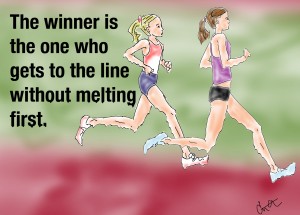
So here’s my running summer warning and tip round-up:
* Beat the Heat:
If you can, it seems like a no-brainer to try and get up and go run before the sun and temps are up, or wait until the later evening.* Acclimate: Here is where you SHOULD actually force your runner butt to run in the heat. If you’re going to be racing under sweltering conditions you NEED to start getting your body used to running in the same conditions. The first runs, and especially hard workouts, are going to not feel all too pleasant. But eventually your body will start to adjust…you do NOT want the first time you go out and run in hot/humid/both conditions to be on race day when you’ve been doing all of your training at 5am to beat the heat. It’ll be like a body slam sucker-punch on race day.
* Hydrate…they hydrate some more: I’ve done some posts HERE and HERE all about hydration. But this needs to be BEATEN into your HEAD here. Hydrate religiously throughout the entire day!! You should be peeing darn near clear, by the time you feel thirsty you’re mildly dehydrated. Also make sure to get those electrolytes replenished as well.
* GI Issues: It’s no coincidence that your tummy may become more upset when the temps rise. I did a post HERE explaining just how much dehydration can be the root cause of lots of running GI disasters. So another reason to stay hydrated…ooor, just go poop your pants…your choice.

Now let’s talk about doing hard workouts and races in the summer scorchers:
* Easy Does It: We already know that going out too fast can be the kiss of death. Doing that in the heat is like putting yourself through Dante’s extra levels of h*ll. You might feel okay at the start but it’ll come slap you hard in the body/face/legs later. This is where you should be running for EFFORT and not times…the heat and humidity are two big factors that slow down times. So adjust your paces accordingly and the power of negative splitting is much friendlier than the brutal kick your butt punishment of going out too fast.
* H2O Cool: If you’re at the track, bring extra water to douse your head and body between reps. Obviously keep some to take sips on, but getting that body temp down the hose-to-head method works well too.
* Seek Shade: Ahhh-duh. If you can find shadier trails to do tempo or fartlek runs on then it’s a no-brainer (vs. an uncovered track). But I also wanted to add this one in here meaning that if you’re doing a track meet and are doubling/tripling/etc. get you butt in the shade as much as possible. No need to have extra energy zapped out of you lingering in the sun unnecessarily.
Whew…and after that, just dream of ice cream and guzzling the entire river once you’ve finished the run. ![]()
1) What’s one of your summer running tips?
2) How bad are you tan lines?
I could blind you from 10 miles away. ![]()
Blog: Cait's Write... (Login to Add to MyJacketFlap)
JacketFlap tags: race tips, tips, interviews, running, motivation, blogs, goals, training, Add a tag
 To run and race your best it’s critical you’ve got the right mindset. Dr. Jim Afremow has made it his mission to help runners and athletes of all sports hone their mental training. Just as important and the physical workouts, an athlete’s mind can create a champion or turn into one’s own worst enemy. I wanted interview Dr. Afremow both because I respect his body of work and level of expertise and also because, let’s be honest, the psychology of our sport in straight-up fascinating! Often time elite athletes have trouble putting into words exactly how they get into gamer mode…so read on to hear a mental game’s coach put words to the ability:
To run and race your best it’s critical you’ve got the right mindset. Dr. Jim Afremow has made it his mission to help runners and athletes of all sports hone their mental training. Just as important and the physical workouts, an athlete’s mind can create a champion or turn into one’s own worst enemy. I wanted interview Dr. Afremow both because I respect his body of work and level of expertise and also because, let’s be honest, the psychology of our sport in straight-up fascinating! Often time elite athletes have trouble putting into words exactly how they get into gamer mode…so read on to hear a mental game’s coach put words to the ability:
JIM AFREMOW, Ph.D.
1) What got you started in athletics, and what were your favorite sports growing up?
I grew up on sports and physical activity primarily through my father who appreciated the importance of having an active lifestyle. He especially enjoyed hiking, mountain climbing, and participating in Masters track and field. As a youth, my favorite sports included track and field, soccer, and golf.
2) How did you foray into becoming a mental games coach and working on the sports psychology end of the spectrum?
Sports psychology provides the perfect opportunity to bridge two of my passions: sports and psychology. I have always been fascinated by human behavior and how all of us can learn to reach our greatest potential. I earned a doctorate in sports psychology and a Master’s in counseling, both at Michigan State University.
3) You work with a variety of athletes in different sports, but in working with runners what are some of the most common mental hurdles they struggle with?
Mental toughness is equally import to physical strength when it comes to shining in sports. Adversity strikes all athletes in different ways at different times. Runners must learn how to stay focused and confidently move through any kind of setback, such as a mental block, performance plateau, prolonged slump, or injury. They must also develop ways to reduce off-field issues or concerns that interfere with their training and races.
4) Confidence is a big one with runners and racing, and confidence tends to ebb and flow, be it after bad workouts or ongoing injuries. What are some of the techniques you use to help runners rebuild and remain confident in themselves and their abilities?
Confidence is a beautiful thing! Confidence in yourself and your athletic ability is critical to performing your best when it matters most. One strategy for boosting your confidence is to remember a particular occasion when you triumphed over a difficult challenge and write about how you made it happen—memory is the prelude to memorable performances.
5) Race day nerves tends to be another big one, what are some of your suggestions for keeping your racing nerves in check?
First and foremost, understand that pre-performance anxiety is how our body readies itself to perform at its peak. So, recognize anxiety for what it is―that’s how humans are made. If you know that, it helps to normalize race day nerves. My new book The Champion’s Mind presents scores of practical tips to help you harness anxiety and use it to your advantage.
6) In running and in athletics in general what is something you feel is an especially crucial mental component in being your best, if not THE best?
Have a big-picture goal and chip away at each and every day. “When you’re good at something, make that everything,” said tennis legend Roger Federer. All it takes is all you’ve got!
7) What’s your favorite mental tip for runners to race and run their best?
During competition, the key word is “performance” because if you focus on performing (rather than on any results or other extraneous factors), then you’re totally in the present. Being in the present and staying purposeful lets you “own the moment” and maximize your abilities.
8) What was the greatest lesson or piece of advice you’ve been given either from a mentor, teacher, or athlete that you’ve applied to your work?
One important lesson is that we either win or we learn. Forget about losing and focus on continual improvement. Give yourself credit where credit is due and celebrate what you did well. But then if you didn’t do as well as you wanted, say, “What did I learn from this that’s going to help me perform better next time?”
9) Tell us about your book, your services, and your website?
The title of my new book is, “The Champion’s Mind: How Great Athletes Think, Train, and Thrive” (Rodale, 2014). The Champion’s Mind explains “what” athletes can do to champion themselves and “how” they can do it. That is, how athletes can fine-tune their game mentally and emotionally to consistently perform at their best. If you want to discover how great you can be and how much fun you can have in your sport, don’t leave the mental game to chance or circumstance.
So, I provide individual and team sports psychology services for personal excellence, peak performance, and team success. Although my private practice is located in Phoenix, I work with athletes from all over the world. Important topics include confidence, concentration, composure, communication, and commitment. All athletes can and should learn how to think like a champion. For more information, please visit my website: www.goldmedalmind.net.
10)Ultimately, what is your goal in being a sports performance specialist? What gives you the most sense of pleasure and fulfillment?
To help people reach their true and full potential in sports and all other demanding endeavors. To help people grow as athletes and as people. Champions think gold and never settle for silver or bronze. They understand that personal best is their ultimate victory. Why settle for anything less?
Blog: Cait's Write... (Login to Add to MyJacketFlap)
JacketFlap tags: tips, running, videos, goals, training, track, exercises, races, workouts, race tips, Add a tag
Everyone wants to run faster, right? Part of getting faster is of course doing the shorter repeats; one must build that explosive power of course. BUT, there’s another part to getting faster and it’s training your BRAIN and nervous system to respond at a quicker rate.
A runner can’t utilize that explosive power to run faster without the nerve and synapse networks first being created to ‘tell’ your foot to move faster off the ground. Isn’t science and the brain cool?
The neuromuscular part of training isn’t something every runner is aware of, but if you’re not addressing it you can run all the 200′s in the world and not really be tapping into your full potential. I’ve written a few articles about the neuromuscular training and how it relates to runners:
* The Multi-Level Approach to Getting Faster
* Work on Getting Faster in Tri-Fecta Form
One of the exercises I mention are ‘Quick Feet Box Taps’. I got an email from someone who wasn’t quite sure if they were doing them right so I decided to make a little video.
You can also find it on my Instagram page. Start with a set of 15-30 seconds and see how many taps you can get. REMEMBER it’s QUALITY over quantity. If you’re getting slopping you’re going to start reinforcing bad habits and that will defeat the purpose. Work up to two sets and do the 3 times a week…preferably as part of your dynamic warm-up routine before workouts or immediately following the workout. It can be fun to watch yourself improve with more taps every week…you know us runners and that competitive spirit. ![]() But again, quality over quantity…so if you have to start slow that’s what you need to do!
But again, quality over quantity…so if you have to start slow that’s what you need to do!
What, you love my shirt too?! Well, thanks…it’s my Ezzere Runner Face Tee! ![]()
Happy Saturday my runner friends. Get those feet firing off the ground, coupling neuromuscular training and speedwork, and watch your PR’s get faster! ![]()
Blog: Cait's Write... (Login to Add to MyJacketFlap)
JacketFlap tags: track, races, race tips, tips, marathon, running, motivation, goals, training, Add a tag
For runners, finding that perfect taper and method to peak right sure can be difficult! Which sounds kinda crazy because taking the taper at face value, one could think, “Well, I just need to cut back. I’ve done all the work, so let’s just coast on until race day and wind up with fresh as daisy legs!”
WRONG. Any runner can tell you tapering is a bit of a beast. Sometimes your legs do feel an extra bounce, other times they start feeling like dead weights and you start to freak out, “What the heck, why am I trucking bricks?!”

Some runners even build a little superstition around it, “The worse my legs feel on the warm-up the better they feel in the race.’ Not going to lie, I’ve experienced that one and can back the logic.
So let’s talk taper. We’ll even start from the most basic of basics up.
What is a taper? Training is done in phases, working backwards from the date of your big race. The closer you draw to your race, the more the goal of workouts shift from ‘building fitness’ to ‘sharpening’ and ‘honing’. A week before your race you’re not going to be able to increase fitness anymore, that work’s been done, so it’s a matter of maintaining fitness and then reducing the volume so your legs feel fresh come race day. [Tapering can be done anywhere from 1-3 weeks before your race, depending on distance and all that good stuff.]
Logistics: Runners who are tapering will cut their overall miles back, the volume of workouts decrease, and you’ll see workouts like 200′s, 400′s, or for marathoners, maybe a few longer repeats (ie: miles) at race pace. Just getting the wheels turning.

Common Mistakes:
1) Not decreasing enough:
If you’ve been training at 110 miles per week and your ‘taper’ is cutting down to 100 miles per week that’s really not going to leave you feeling all that fresh, right? Same goes with pushing your ‘taper’ workouts too much; grinding out your best 6xmile four days before your race day isn’t doing you any favors.2) Decreasing too much: So the runners who think, oh I’ll just go from 110 miles down to 20 and I’ll feel GOLDEN! Wrong-zo. The body has a crazy way of adapting to us crazy runners and doing what we do. Dramatic shifts, the body doesn’t like that at all. Go too far from one extreme to the other and your body will be like, “wtf is going on?!” In the case of the runner above, they’ll actually be feeling sluggish because their body is used to much more stress. It actually NEEDS more miles to feel better. Crazy, huh? But kinda cool too.
Bottom line: There’s no perfect amount for everyone, it comes back to what works for you and your race distance. But a nice rule is that when tapering your mileage should be reduced by 20-25% of your average training volume.
3) Pre-Race Day Off: Many runners like to take the day before their race completely off. I would like to argue that, they should instead take the day TWO days prior to their race off. Why? Sometimes your legs will feel stale after a complete rest day, it’s better to do a short shake-out run and strides the day before to ‘bust out the rust and creaks.’ You still get a day off, but going into the race you’re not ‘creaky’. This is also why if you’re running a night race, lots of runners like to do a short (10-15min) shake-out run that morning.
4) No Speed-work: Taper logic might seem like you shouldn’t do anything hard…go into the whole week totally fresh and rested. Refer back to number 2 and realize that once your body has become accustomed to a certain degree of work (ie: stress) it needs the stimulus. Going 4-plus days without any faster turn-over will leave your legs feeling sluggish and slow. For races 10k and below, a good workout to do three days before your race is 8x200m with 200meter recovery. Any way you slice it, you still want some ‘sharp’ quality sessions leading up to your race.
Tapering is a tricky science, that’s why I firmly believe runners should have a coach they trust to do the sciencey planning stuff. Then the runner isn’t left ‘thinking’ all this out. Planning and wondering “is this workout right? Is this what I should do?” can get in the way of your workouts, and it can be liberating to give that ‘stress’ to someone else who KNOWS their stuff.
That way, runners can just turn their brain off and stick to what they love to do…run. Hey, running the workouts are hard enough, no reason to add more thinking than necessary to the mix. ![]()
———-
More posts on RACE TIPS
More posts on PRE-RACE CONFIDENCE
Make sure you’re looking GOOD doing all that training…Ezzere’s got your back there! ![]()

———
Blog: Cait's Write... (Login to Add to MyJacketFlap)
JacketFlap tags: tips, running, Cartoons, motivation, goals, training, exercises, stretching, core, Add a tag
Good things can come in threes, but then again plenty of awesome things come in twos and fours. Runners have two legs, four laps make that perfect mile…though do those four laps REALLY feel all that perfect when doing mile repeats?? ![]() Brain: “FOUR laps, let’s call a mile one lap!” Juuust kidding.
Brain: “FOUR laps, let’s call a mile one lap!” Juuust kidding.
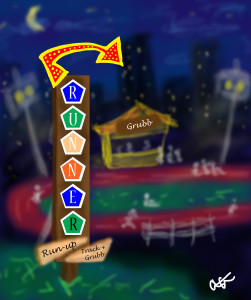
The cool place all runners get to hang out.
Well good things can come in any number but today you runners are getting a three-pack. Here are some Training Tips in Triple for your Tuesday:
1) Runners Who Skip: Runners can become a little too linear for their own good. Example is looking only at their running workouts to improve and taking that little metaphor to the literal: running is a repetitive, linear, single-plane action. If you don’t work your body in a variety of ways it gets tight. Tight will equal restrictive, bring you injuries and impede your speed.
Offset that by doing things OTHER than running: core work, flexibility, and agility drills. Move in the horizontal, even do some skipping to ‘dilly around’ with your neuromuscular thought patterns. Your brain actually has to be ‘played with’…it gets stuck in a pace/pattern run with just running. So as crazy as it sounds doing things like skipping, backwards skips, crazy feet drills give it a little ‘reset’ and make it more ‘sharp’ when you come back to running steps. Oh, and those fast feet, like chili pepper jump rope things, those will help your neuromuscular training too…get those feet conditioned to FIRE off the ground faster = faster speed and sprinting.
2) Be Quiet I’m Sleeping: Sleeping should really be an Olympic sports…or at least one of everyone’s favorite past times. Want to have a sleep-off? Just kidding. But seriously, for the runner in training you should guard your zzzz’s with just as much ferocity as you do lane one during repeats.

Sleep is where you body does the vast majority of its repair, sleep is a restorative process. But it’s really the deep, REM sleep that you need. That’s why people who are light sleepers or wake up multiple times in the night can still feel so flipping tired later even if they’ve been in bed 8-12 hours…they’re not sleeping continuously or getting a deep enough sleep. Sleep issues are really tricky, I’ve got them, so if you do have trouble sleeping already do the basics: make it as dark as possible, don’t even have the light from your phone on, try a fan for white noise, relax and power-down before bedtime to put your brain in sleep-mode, and from there you may need to seek out some other options and work with a doctor.
For those of you are are lucky enough to NOT have a problem sleeping but just skimp on the hours because you’re busy, I’ll say this: 1) you’re only hurting yourself and your training 2) you’re taking sleeping for granted…trust me, lots of us insomniacs would die to get some extra hours!! haha…take advantage of them and aim for 8-9 hours a night for optimal performance.
3) Laugh: Wow…you think I’m a nutzo for just saying that. I’ll go on record and rattle off just why laughing is a training necessity:
* Running is hard: yea, it’s painful. But misery loves company and laughter. Those slow jogs between intervals is when you and your training buddies should be making fart jokes.
* De-serious: It’s easy to be too serious in life and apply that to training. Ironically getting ‘too’ focused on your workouts and training has a funny way of making you eventually start slowing down. It’s because of pressure and it’ll also rob you of the passion…both recipe for disasters. Make sure you’re excited and focused on your goals…but still ENJOY it. So laugh.
* Running gets awkward: Need I say more? Runners will have to fart, burp, poo, chafe, adjust a wedgie etc. mid-run. It’s just funny, get over embarrassment and do it. Make a joke about it.
There ya go. Take this Tuesday and make it a point to improve your running in three ways. Heck, please apply the laughter part to your overall life too!
———-
Related Read: My latest article on RunBlogRun: Running the ‘Extras’: Think outside the miles and improve your performance
Another of my new articles on RunBlogRun: Young Runners and the Issues of Volume and Intensity
Need a laugh? My CARTOONS are here for you! ![]()
———-
Blog: Cait's Write... (Login to Add to MyJacketFlap)
JacketFlap tags: tips, running, motivation, goals, injuries, training, core, cross training, Add a tag
A headline caught my eye recently: “Be a better runner without running.” *About face* Now I respect the news outlet that ran the article but the snark in me can’t resist thinking, “This kind of thing belongs in Runner’s World next to the column ‘How to get faster in your sleep!’”

Track dreams…but you still need to actually run on the track too. ;)
In seriousness though, yes there are ways to improve your running and get faster that aren’t running. HOWEVER, these are thought of like ‘extras’…you still have to run.
Everybody and every BODY handles a different amount of volume and quality. Not everyone can log 110 miles per week, with a hard speed session, endurance session, and long run in a 7 day cycle. Some people can run 170 miles per week just fine, others get hurt going over 50…waaah-waahh it’s not fair but that’s how it is.
Know your body. Know your limits and maximize them. Just because you can’t RUN more than 50 miles per week does not necessarily mean you can’t beat the runner doing twice your volume. Enter QUALITY.
Here are a few quick tips on maximizing your training if you’re a runner who is a little more ‘fragile’: (ie: improving your running with running less and doing other stuff)
* Extend Your ‘Week’: By this I’m talking about viewing your training cycle as 9-10 days rather than the standard 7. Meb Keflezighi has talked about doing this as he’s aged, and many masters runners work off of a longer training week. This allows for more recovery between hard workouts.
* Rule of 10 and Baby Steps: If you’re injury-prone already you know you need to BABY your body a bit. Only increase your miles by 10% each week. Then be honest with what your mileage ‘max’ is. If you start getting extra creaking when you kiss 50, stick there and supplement with extra cross training instead of miles.
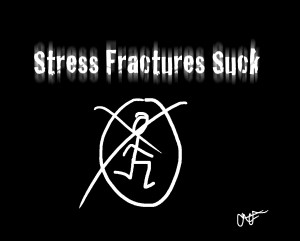
* Swap Your Easy Runs: Plan your miles for the week and ‘save’ them for your hard workouts and long runs. Those are the days that will give you the most bang for your mileage buck. Cross train on the easy days; to be honest the benefit of easy days are mostly just getting the steady cardio in…you can do that running or cross training. The former is just a lot easier on your body.
* Seek Soft Surfaces: The pavement is harder on your body than the trails, track, and treadmill. Seek these softer surfaces. Also know that lots of downhill running exponentially increases the impact on your joints, so steer clear of huge, sharp downhills.
* Get More Efficient: Most injuries are a result of a weakness and muscle imbalance. Fix those and you’ll be running more efficient and most likely be able to handle running more. All the more reason to fix your form, get a stronger core, and solve why you might be stuck in a vicious cycle of injuries.
* Fitter With Cross Training: Ideally you want to be doing your hard workouts as running because this will translate the best for racing but you’d be amazed by how fit you can stay with cross training workouts. So if you have to do some of your ‘running’ workouts on the cross trainer don’t freak out and remember it all comes back to effort. Go hard, get your heart rate up, feel the burn in your legs and lungs, and you’re getting work done.
Not EVERYTHING that will get you faster comes from running more miles. Think outside the box, learn your body, and maximize your potential.
Though the snark in me still has to end with this: “but, duh, you still have to do some running.” ![]()
——-
More articles on cross training and workout ideas!
More articles on injuries, recovering, and how to prevent them!
Blog: Cait's Write... (Login to Add to MyJacketFlap)
JacketFlap tags: races, race tips, tips, running, training, track, motivation, goals, nutrition, Add a tag
Now my younger brother’s first love is rugby, second is football, but for the three weeks between seasons he decided to do track! Wahoo…I was stoked!! I’m also in awe of the fact that he doesn’t do any speed-work and then just blitzes those 400′s and 200′s like they’re nothing.

The mystery is solved as to where all of the fast twitch muscle fiber genes in the family went. Clearly all were saved and concentrated into the youngest Chock sibling. Oh and I guess he stole my coordination genes too. ![]()
Granted he’s got the competitiveness of a Chock, so he’ll gut out a race and pay the price after to hit those marks. But the truth is that last 100 of a 400 isn’t fun for anybody, no matter if you’ve trained or not…BLECH…talk about booty lock.
Checking out those high school meets has been fun, observing just as much so, and here are a few tips I’d pass on if teenagers actually cared to listen to us old folks:
* Warm-up and Recovery:
set yourself up to run your best, not warming up before a race is setting yourself up for both injury and running below your maximum potential. Cold muscles no likey sprinting. The same for after your race, do all you can to recover so you can come back stronger. That includes a cool-down and refueling within 30 minutes of finishing.* Drafting and Tangents: it was windy at the track meet and those are days where you really want to draft. Leading expends more mental energy and on windy days it expends a heck of a lot more physical energy to lead. If you can, tuck in behind somebody until you’re really to surge past them. When you DO make your move, try to make it on a straight away…running the tangents on a race course is the same idea, don’t run more than your race distance or your competitors are.

* When You Pass, You PASS: racing is mental like that, when you make a move and pass someone you want to be passing them for good. Conserve energy and then blow by that sucker! Don’t ‘weakly’ pass them because then they can just tuck in behind you and let you do the work. You want to BLOW by them and try to mentally break them. Make them think, “Dang, they’re feeling much stronger than me, I can’t keep up.” Even if you feel like crap, it’s a race, you should feel tired, but your competitors don’t have to know you’re tired as heck and clinging on until the finish line. Break them and leave them in your dust.
* Cling-on: sorry, no sci-fi reference, but this speaks to those getting passed. Read above. You can’t get in the mind of your competitors and chances are they’re working, tired, and hurting too. If they pass you, rally the troops and try to stay with them. Don’t let THEM mentally break you. See, it works two ways like that. ![]()
The last thing I’ll add, while I like to joke that I have not a single fast twitch muscle in my body (I’ve never been biopsied, but I’ll say I probably only do have one!) DON’T use that as an excuse to avoid speed-work. It’s incredible how much you can manipulate and overcome your natural predisposition in terms of speedster versus endurance maven. You’d be surprised that, yes, even ye of one speed can get some wheels on themselves and wind up with really strong kicks.
The thing is you just have to train those muscles! For speed you need to build power (hills, sprints, plyo’s) and all that good stuff is plenty of fodder for another post!
Get out there and kick some butt…embrace the booty lock too! ![]()
——–
Have you checked out my Ezzere Running Tees yet?? Mosey over, folks!!
Send MAJOR cheers to one awesome Kim @ Day with KT this rockstar runnerchick and mom is out to kill it at her 50 mile race this Saturday!! WAHOOOO!!!
Blog: Cait's Write... (Login to Add to MyJacketFlap)
JacketFlap tags: nutrition, training, tips, reviews, running, Add a tag
Hydration is not something runners can afford to skimp on. Fun fact: by the time you actually FEEL thirsty you’re in a state of dehydration. The key is sipping those fluids consistently, throughout the day, and ensuring you’re urine is rocking the clear-light yellow hue rather than radioactive yellow-orange.
With summer fast approaching and the hotter temps that accompany, it’s important runners are issued a reminder just HOW crucial it is to stay hydrated. If you don’t, your performances will suffer but more importantly it could become dangerous. Dehydration can also wreck havoc on your stomach and intestines.
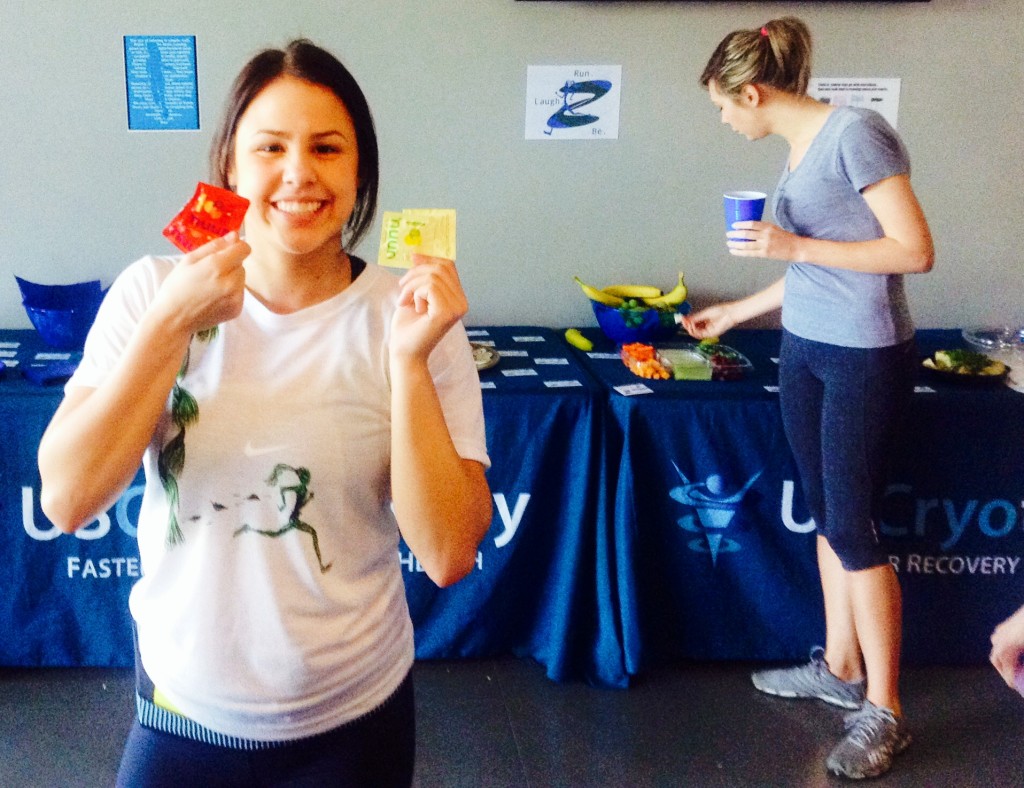
For runners, hydration is more than just drinking water. Water is essential but so are electrolytes. When you sweat you lose more than just H2O; electrolytes, like potassium and sodium, are also lost through sweat and are just as important to replace. When electrolytes get unbalanced, that’s when you run the risk of heart issues and other complications due to an overly dilute blood stream. Not fun. Besides, before you even get to THAT dangerous of a point, your running will be sub-par if you’re not hydrated fully with water AND electrolytes.
Our good friends at Nuun have been supplying those cool tablets that you can drop into your water bottle, shake, and voila have your electrolyte-infused (and tastified) drink for years. They’ve introduced their new Nuun Energy line and I served it at my Ezzere Launch Party even! Nuun was generous enough to give samples to all of my guests and put together a prize pack for this lucky winner…

He’s excited, he’ll never be dehydrated. ![]() Here’s the scoop on the new Nuun Energy:
Here’s the scoop on the new Nuun Energy:
* Electrolytes: These new Nuun tablets have all the essential electrolytes as the pervious Nuun Active Hydration line as well as extra B Vitamins and a bit of caffeine.
* No Sugars: There’s not any extra sugar added, meaning you can replace your electrolytes without tons of excess calories. Each tablet is less than 12 calories which, unless you need immediate glycogen while running a marathon, is what most runners are looking for in this type of hydration performance supplement. Unless you’re needing to gain weight, a common mistake runners can make is drinking too many unnecessary calories by way of sports drink. Namely because of a high sugar content. Not so with Nuun.
* Caffeine: The extra caffeine (40mg) perks you up and certain studies have shown that a small dose of caffeine pre-workout or race can give you a boost there.

The Taste Factor:
I like that Nuun adds a nice flavor to my water but doesn’t turn it into Kool-Aide. It’s not overly sweet. “It’s fizzy!” one of the guests of my Ezzere Launch Party squealed in delight. These new flavors have a cool fizz to them and I liked that, as did my guests.
The new flavors are Wild Berry, Lemon Lime, and Cherry Limeade. My favorite was the Wild Berry. They come in the portable vial which is handy to take anywhere and infuse your water. Thank you, Nuun, for joining my party and donating your new Energy drink!
NO EXCUSES, Runners, you can stay hydrated all day long. Your running will thank you, heck, even normal people need to be conscious of staying hydrated…it’s just when you’re asking your body to perform at its best it’s THAT much more important you give it the fluids and electrolytes it deserves!
——–
Check out my latest Active Article: How to Settle Your Race Day Jitters
SUPER stoked to be able to catch up with David Torrence, he’s killing it this year and only going to be setting more records, so check out my story on him over at RunBlogRun: Records Falling and David Torrence is Hungry
View Next 25 Posts







